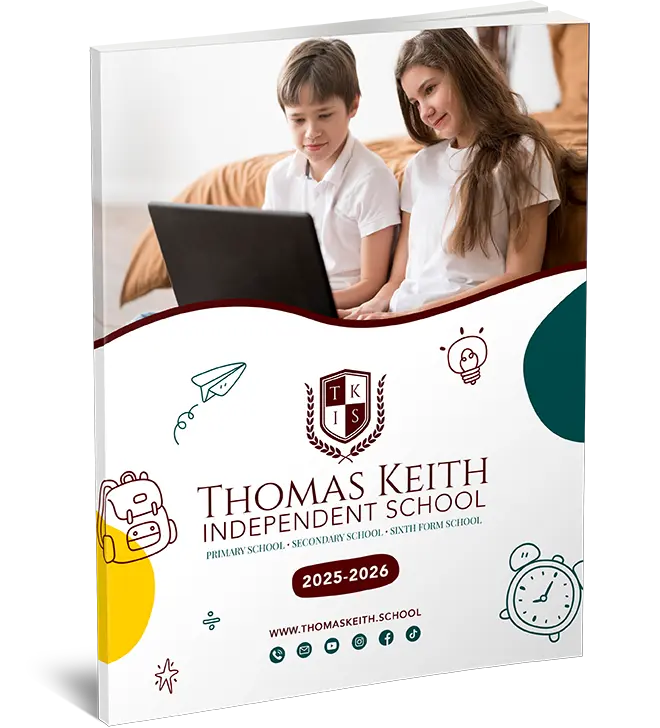The Benefits of Bilingual Homeschooling
Introduction to Bilingual Homeschooling
Bilingual homeschooling offers numerous advantages, contributing significantly to the cognitive and linguistic development of children.
At Thomas Keith Independent School, we recognise the multitude of benefits that bilingual education can bring, thus actively incorporating bilingual strategies into our curriculum.
But what exactly is bilingual homeschooling?
Bilingual homeschooling involves educating children in two languages concurrently.
This approach not only promotes language proficiency in both languages but also fosters cognitive flexibility, enhancing overall learning abilities and problem-solving skills.
It caters to the growing needs of families who value cultural diversity and seek a more personalised educational framework.
Research highlights that children who engage in bilingual homeschooling often exhibit improved attention span and multitasking abilities.
The brain’s ability to switch between languages boosts executive function—a critical skill set for academic success and beyond.
Furthermore, bilingual homeschooling opens doors for children to explore global cultures, enhancing their social awareness and empathy.
Implementing a bilingual homeschooling environment requires careful planning and resources.
Parents and educators must select appropriate curricula and teaching materials that align with children’s linguistic levels and learning needs.
Fortunately, advancements in technology provide ample resources—such as language-learning apps, online classes, and interactive platforms—that support homeschooling families in their bilingual education journey.
Lastly, at Thomas Keith Independent School, we believe that bilingual homeschooling doesn’t just prepare students for academic challenges, but it equips them with the essential skills required in a multicultural world.
As language plays a vital role in shaping thought and communication patterns, bilingual homeschooling could truly be a transformative educational experience for children, setting the foundation for a successful future.“`html
Why Choose Bilingual Homeschooling?
The Benefits of Bilingual Homeschooling are significant and multifaceted, making it a compelling choice for many families.
In today’s globalised world, the ability to converse in multiple languages is more valuable than ever.
Bilingual homeschooling provides a personalised learning environment that caters to the individual language capabilities of each child.
This approach allows for a more flexible and tailored educational experience, adapting lessons to suit the learning pace and interest of the child.
One of the primary reasons parents opt for bilingual homeschooling is the cognitive benefits associated with learning multiple languages.
Research indicates that bilingualism can enhance cognitive flexibility, improve memory, and increase problem-solving abilities.
These skills are crucial for academic success across primary, secondary, and sixth form stages.
Moreover, bilingual education fosters empathy and cultural awareness, preparing pupils to thrive in diverse environments.
In addition to cognitive advantages, bilingual homeschooling offers the benefit of direct language immersion.
Unlike traditional schooling, where language learning might be limited to a few hours a week, bilingual homeschooling can integrate language into daily routines and activities.
This constant exposure helps students achieve fluency and confidence in their language skills more rapidly.
Homeschooling bilingually also offers the flexibility to incorporate cultural elements into the curriculum.
Families have the opportunity to explore literature, history, and media in both languages, thus enriching the educational experience and fostering a deeper understanding of multiple cultures.
This dual exposure is indispensable in developing a well-rounded worldview.
Furthermore, bilingual homeschooling allows parents to create a learning environment that aligns with family values and educational philosophies.
For many families, this includes fostering a love for languages early in life, which can be pivotal in achieving long-term language retention and enthusiasm.
Ultimately, the choice of bilingual homeschooling is driven by the desire to provide children with comprehensive, adaptable education that prepares them for a future in an interconnected world.
As Thomas Keith Independent School continues to advocate for innovative education methods, the Benefits of Bilingual Homeschooling remain a prominent element of our varied curriculum offerings.
Advantages of Bilingual Homeschooling
The Benefits of Bilingual Homeschooling are multifaceted and extensive, making it an appealing educational approach for many families.
Firstly, bilingual homeschooling fosters cognitive development in children beyond monolingual capabilities.
Numerous studies have shown that learning multiple languages enhances brain function, improving skills such as problem-solving, multitasking, and creative thinking.
As your child navigates both languages, they develop the ability to switch between tasks more efficiently, thus sharpening their mental agility.
Moreover, bilingual homeschooling provides a significant advantage in terms of cultural competence.
By interacting with diverse languages, children gain an appreciation for different cultures and perspectives, promoting tolerance and understanding.
This cultural awareness is crucial in today’s globalised society, as it equips learners with the insights and adaptability needed in various contexts.
Furthermore, studying bilingually at home offers educational flexibility that traditional schooling systems may not provide.
Parents can tailor the curriculum to meet the specific learning needs and interests of their children, allowing for a customised approach to education.
This level of personalisation ensures that each child’s unique skills and inclinations are nurtured effectively.
The Benefits of Bilingual Homeschooling also extend to the development of linguistic skills essential for future career opportunities.
Proficiency in multiple languages opens doors to a wider range of job prospects.
In many sectors, such as international business, diplomacy, and media, bilingualism is a highly valued asset, offering competitive advantages in the job market.
In addition, bilingual homeschooling can streamline family dynamics by involving parents more intimately in their children’s education.
This engagement not only strengthens parent-child relationships but also allows parents to impart their values and traditions directly, fostering a cohesive family unit.
It is essential to note that homeschooling bilingually can be a positive environmental choice as well.
By eliminating the daily commute to school, families contribute to reduced carbon footprints, aligning with eco-friendly values.
Lastly, the advantages of bilingual homeschooling are reflected in the soft skills development in children.
Learning two languages naturally encourages self-discipline, time management, and organisational skills as children adapt to the demands of bilingual education.
These are crucial skills that will serve them throughout their educational journey and beyond.
In conclusion, The Benefits of Bilingual Homeschooling are comprehensive, offering academic, personal, and societal advantages that make it a compelling educational strategy for the modern world.
At Thomas Keith Independent School, we understand these benefits and strive to support your family’s bilingual homeschooling journey with resources and expertise.
Challenges and How to Overcome Them
The Benefits of Bilingual Homeschooling extend beyond cognitive development and language skills, but there are challenges involved that parents and educators need to address.
Understanding these challenges is crucial as it allows for proactive planning and implementation of effective strategies, thereby maximising the advantages of bilingual education.
A primary challenge in bilingual homeschooling is maintaining consistency in language usage.
This is often difficult in environments where one language predominantly dominates social and media landscapes.
Parents must therefore make a conscious effort to balance both languages.
One effective method is to designate specific times or activities for each language, creating a structured yet flexible routine.
Another significant hurdle is the potential for language confusion or delay in younger children.
While some studies suggest bilingual children may take longer to speak initially, research indicates this does not affect long-term language development.
Parents should engage in daily language practice and avoid overly focusing on comparing their child’s language milestones with monolingual peers.
Access to resources can also pose a challenge in bilingual homeschooling.
Materials may not always be available for minority languages or could be expensive.
Utilising online resources, such as language apps, or community resources like libraries can provide significant support.
Bilingual homeschool networks and online communities are invaluable for sharing resources and advice.
Time management is another area where bilingual homeschooling can become challenging.
Balancing language instruction with other educational requirements and daily tasks can be daunting.
Adopting a clear schedule is critical, aiming to integrate language learning with core subjects to enhance cross-curricular connections.
Finally, sustaining motivation and interest in both languages requires creativity.
Incorporating cultural elements such as music, films, and virtual exchanges with native speakers can enrich the learning experience and keep it engaging.
By addressing these challenges with thoughtful strategies, parents can fully harness the Benefits of Bilingual Homeschooling, providing their children with a holistic and enriching educational experience.
The Benefits of Bilingual Homeschooling: Tips for Successful Bilingual Homeschooling
The Benefits of Bilingual Homeschooling extend beyond language acquisition, offering a rich environment for cognitive growth and cultural awareness.
Successfully navigating bilingual homeschooling requires strategic planning and commitment.
Here are several tips to ensure an effective bilingual homeschool experience.
First, establish a consistent schedule that integrates both languages throughout the day.
Consistency is key in language learning, and adherence to a routine helps children develop fluency organically.
Including specific times for each language while also incorporating subjects that naturally employ both can enhance bilingual competencies.
Leverage diverse resources and tools to enrich your bilingual homeschooling journey.
Consider using technology, such as language learning apps, online tutors, and interactive games, to support language acquisition.
At Thomas Keith Independent School, we provide access to curated digital resources that complement our bilingual curriculum, maximising the exposure to both languages.
Engage with the broader bilingual community.
Participating in language-focused social events, forums, and local meetups provides practical experience and encourages active language use in social settings.
Networking with other bilingual homeschooling families can also provide valuable insights and shared experiences.
It’s vital to be patient and maintain a positive environment.
Celebrate milestones and progress, no matter how small, to motivate your child and reinforce their efforts.
Create a supportive atmosphere where mistakes are seen as learning opportunities, thus fostering a growth mindset towards language learning.
Finally, adapt your approach to fit the individual needs of your child.
Every learner is unique, and personalising your teaching strategy can make bilingual homeschooling more effective.
Regularly evaluate your child’s progress and be prepared to adjust the teaching methods or resources to best suit their evolving needs.
By following these tips, you can optimise The Benefits of Bilingual Homeschooling and create an enriching learning experience that prepares your child for a multilingual world.
![]()
Incorporating Technology in Bilingual Homeschooling
In today’s connected world, incorporating technology into bilingual homeschooling is essential to fully realise the benefits of bilingual homeschooling.
Technology provides a dynamic platform for engaging students in interactive learning experiences while supporting a bilingual curriculum.
Tools such as online language resources, educational apps, and virtual classrooms offer diverse opportunities that enhance language learning and make it more engaging for students.
Online education platforms and resources are readily available to provide lessons in both languages, catering to different learning styles.
For instance, language learning apps such as Duolingo and Rosetta Stone are invaluable online tools that offer structured lessons and practice exercises, promoting both English and a second language.
These platforms often have gamified elements that keep students motivated and make learning enjoyable.
Video conferencing tools and online language exchange programmes also open up opportunities for students to practise speaking skills with native speakers from around the world.
Such interaction not only improves language proficiency but also exposes students to different cultures, further enriching their learning experience.
Digital literacy is a crucial skill for future success, and incorporating technology in bilingual homeschooling ensures students become comfortable with various digital tools.
Parents and educators can leverage online resources to track progress and adapt curricula to meet individual learner needs, facilitating a tailored educational experience.
Moreover, using technology in bilingual homeschooling encourages active learning, fosters autonomy, and prepares students for a technologically advanced society.
While incorporating technology, it’s essential to ensure that screen time is balanced and online materials are appropriately vetted to maintain educational quality and relevance.
At Thomas Keith Independent School, we advise integrating technology thoughtfully to complement traditional teaching methods and support bilingual learning outcomes.
This balanced approach ensures that students not only gain linguistic proficiency but also valuable digital skills essential for their future academic and professional endeavours.
Sample Bilingual Homeschooling Schedule
The Benefits of Bilingual Homeschooling extend beyond linguistic skills, fostering a structured daily routine that can be both enriching and flexible.
Creating a balanced bilingual homeschooling schedule can significantly enhance educational outcomes, providing an organised framework that respects both academic rigor and creative exploration.
A typical bilingual homeschooling schedule might begin with morning sessions dedicated to subjects in one language, for example, reading and mathematics in English, allowing children to sharpen their linguistic skills through immersion in a specific context.
As the day progresses, the schedule can introduce lessons in the second language, such as science or arts in Mandarin or Spanish, helping the child develop fluency and switch seamlessly between languages.
Incorporating interactive technology tools can also aid in facilitating language learning and maintain engagement; apps for language exercises can be seamlessly integrated into the daily routine.
Breaks between sessions should be strategically planned, ensuring they are adequately spaced to allow for mental relaxation and creativity, often involving play or physical activity to refresh the mind and body.
For example, a midday pause with interactive language games or outdoor activities conducted in the minority language can encourage children to apply linguistic skills in practical situations.
Afternoon lessons may include project-based learning, encouraging high-level thinking and problem-solving capabilities across both languages.
Adapting the schedule to meet the needs of each student, for example by incorporating personalised learning plans, can maximise the effectiveness of bilingual homeschooling and ensure that all learning modalities are catered to.
At Thomas Keith Independent School, we understand the importance of customisable educational frameworks, and a well-crafted bilingual homeschooling schedule is instrumental in leveraging The Benefits of Bilingual Homeschooling.
Parents are encouraged to collaborate closely with educators to refine schedules that best suit the individual learning curves of their children, ensuring the homeschooling experience is as rewarding and effective as possible.
![]()
Conclusion: Embracing Bilingual Homeschooling
The Benefits of Bilingual Homeschooling extend beyond academic excellence, offering a gateway to cultural richness and cognitive enhancements.
Embracing bilingual homeschooling is a decision that empowers both parents and children to cultivate a learning environment rich in linguistic diversity and cultural awareness.
By incorporating multiple languages in homeschooling, families can foster an inclusive environment where learning becomes an expansive and engaging experience.
The journey of bilingual homeschooling encourages students to develop critical thinking skills and adaptability, preparing them for a globalised world.
Parents play an instrumental role in guiding this educational path, ensuring that the knowledge imparted transcends linguistic boundaries.
At Thomas Keith Independent School, we understand the importance of adapting to a changing educational landscape and providing resources that support bilingual learning.
Ultimately, the commitment to bilingual homeschooling enhances family connections and creates lifelong learners who appreciate the diversity of the world.
By embracing bilingual education, families are not only broadening their academic horizons but also enriching their personal lives through shared experiences and cultural exposure.




